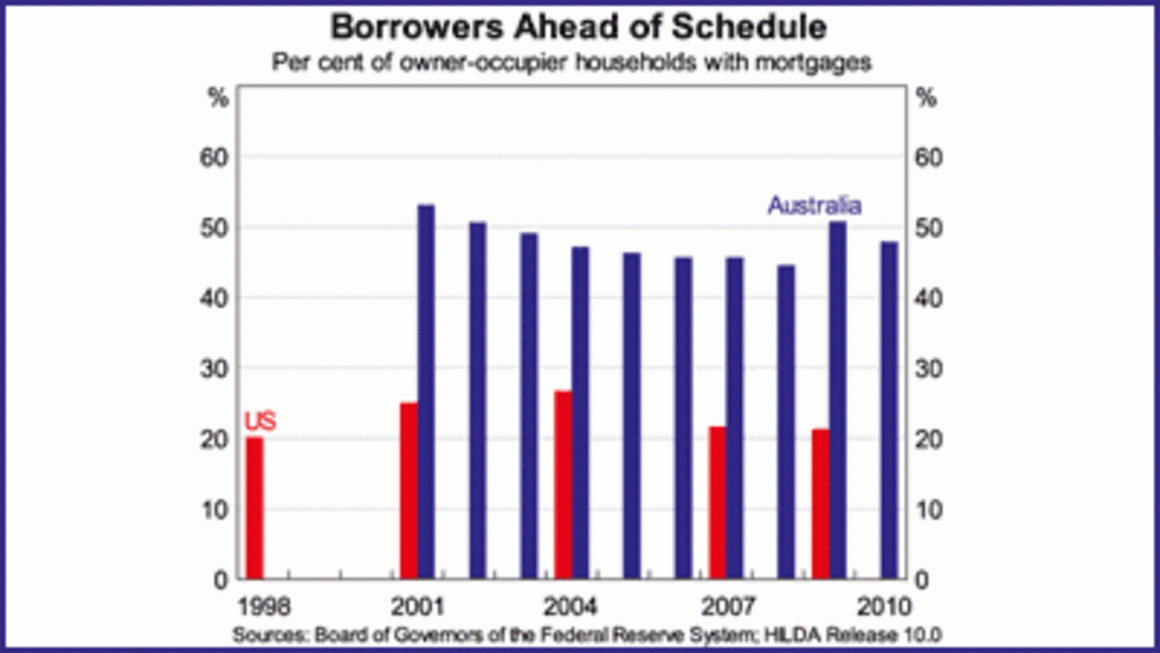Australians pay off their mortgages faster than Americans: RBA

Australians care more about home ownership than US home owners and take a more prudent approach to lending and debt, Luci Ellis, head of the Financial Stability Department at the RBA, has told a mortgage conference in Atlanta.
Speaking ahead of a panel discussion on the topic of mortgage financing, Ellis began by telling US financiers: “Americans are not obviously more enamoured of home ownership than other people. We talk about a ‘Great Australian Dream’.’”
She presented the following graph to show that Australians are better at managing their mortgages than US borrowers paying their mortgages down ahead of schedule.
It shows that during the last 10 years around half of Australian borrowers have been ahead of their mortgage repayments schedule while in the US this is closer to 20% of borrowers. (Australian authorities report more regularly on mortgage repayment rates).
Click to enlarge“American households are less likely to pay their mortgages down ahead of schedule than Australians,” Ellis said.
“Trade-up buyers seem to have high loan-to-valuation ratios in the United States; that doesn't appear to be true in Australia. The result of all this is that the US housing stock is far more leveraged than that in Australia, even during the boom period,” she said.
Her remarks come as overseas investors continue to express concerns about the Australian housing market and shun buying Australian residential mortgage-backed securities.
“I have a US colleague with me at the moment and he says Australia has the most overvalued housing market in the world and that is has a serious bubble,” Peter Dorrian, head of global wealth management at the Australian arm of investment firm Pimco, told Business Spectator earlier this month.
In her speech, Ellis pointed out the uniqueness of the US financial meltdown, which was precipitated by a mortgage crisis.
“In most countries, by contrast, increased mortgage distress occurs with economic downturns; it doesn't usually precipitate them,” Ellis said.
Ellis identified four key factors that caused the US meltdown, beginning with the fact that had been a housing and construction boom ahead of the crash, creating an “overhang of excess supply”.
“The inherent stock-flow interaction in the housing market means that construction booms sow the seeds of their own destruction. Prices can undershoot formerly sustainable levels,” she said.
She also pointed out the weaker lending standards, which exacerbated the tendency of mortgage borrowers to default in a bust.
“There were gaps in both prudential and consumer protection regulation. Even where those regulations applied, they did not prevent lending practices not seen elsewhere, especially around income documentation and amortisation,” she said.
She said loans in the US discouraged amortisation.
“Interest-only loans, explicitly negative amortisation loans and cash-out refinancing, all meant that loan-to-valuation ratios that were high at origination, stayed high well into the life of the loan.”
Lastly she highlighted wider policy choices that were having an effect on the mortgage market.
“The United States has chosen a host of institutional arrangements outside the housing–finance system that result in US households facing more idiosyncratic and collective risk than their counterparts in many other developed countries.
“Flexible labour markets, limited welfare systems and US-style healthcare and elder care systems are understandable policy choices. But these policy choices have implications for what can be safely managed in the housing–finance system. This fact needs to be taken into account when designing mortgage and housing policy.”
Ellis said fixing the US system would solve what she called the reversal of an aversion to on-balance sheet mortgage lending.
“During the boom, on-balance sheet mortgage lending was not seen as being a profitable or attractive business for US banking institutions.
“That is extraordinary to foreign eyes. I believe that a healthy mortgage market is only feasible when sound mortgage lending is an attractive business for prudentially regulated firms; ideally, it should be possible for these firms collectively to dominate that industry, even if they do not in reality,” she said.
“I also think more could be done to encourage mortgage amortisation. Paying your mortgage down before the bust is the most effective way of avoiding getting into negative equity once housing prices start to fall.
“It might be worth considering adjustable-rate mortgages in a more positive light. They offer some advantages, at least if they do not have aggressive teaser rates. In particular, they allow the borrower to make prepayments that can be redrawn later if needed. Think of this as like a home equity loan where the maximum balance declines over time.
“Such loans are common in Australia and have proven a highly effective vehicle for precautionary savings.”
